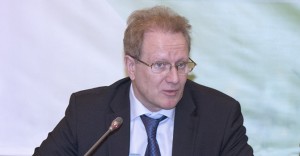 The mining metallurgical complex (MMC) is one of the key sectors of the economy, the development of which directly affects the level of GDP growth. First Vice-Minister of Industry and New Technologies Albert Rau recently discussed the achievements and prospects of development of this industrial sector.
The mining metallurgical complex (MMC) is one of the key sectors of the economy, the development of which directly affects the level of GDP growth. First Vice-Minister of Industry and New Technologies Albert Rau recently discussed the achievements and prospects of development of this industrial sector.
What are the overall results of the mining and metallurgical industry of Kazakhstan since the start of the State Programme of Accelerated Industrial and Innovative Development (SPAIID)? How many projects have been implemented?
The mining and metallurgical complex remains one of the key areas of the economy and an attractive investment target. MMC development has a pronounced social character – this sector employs more than 300,000 people, which makes it one of the most intensive industries in terms of employment. Alongside that, it is a centre of significant investments, including in the framework of SPAIID projects.
As for overall performance, the production volume of metal industries grew from 1,569.9 billion tenge (US$8.486 billion in 2010 to 1,772.1 billion tenge in 2013 (US$9.579 billion); the volume of ore mining increased from 651.2 billion tenge (US$3.5 billion) in 2010 to 786.2 billion tenge (US$4.2 billion) in 2013; production of final metal products increased by 2014 from 95.9 billion tenge (US$522.5 million) to 169.9 billion tenge (US$925.7 million), which has been achieved largely due to the expansion of production and commissioning of new enterprises within the first five-year SPAIID.
The volume of exports of steel products grew by the end of 2013 from $8.9 billion to $13.5 billion; labour productivity in the steel industry has increased by 63.7 percent since 2008.
In general, due to the implementation of the programme for the development of the mining industry of Kazakhstan for 2010-2014 and the launch of projects included in the Industrialisation Map, MMC demonstrates stable growth of economic indicators. It’s worth noting that the programme also envisaged the development of energy and transport infrastructure of MMC, training of personnel and a range of other measures aimed at improving the technical regulations, creation of conditions for technological upgrading of enterprises and attracting investments in the sector.
About 50 projects were launched within the Industrialisation Map in the period of 2010-2013 and currently another 33 projects are under implementation.
As a result of this work the enterprises of the industry have mastered production of 106 new commodity items that were not previously produced in Kazakhstan, among which are naval metal constructions, turbine overpasses, composite metal pipes, cables, metal plumbing, various fittings and others. Overall, the contribution of industrial projects of MMC to the manufacturing industry was 7.5 percent; to the gross added value of the industry, 2.6 percent and to the national GDP, 0.9 percent.
What is the proportion of MMC projects in the total number of industrial projects?
Within the framework of the Industrialisation Map, 83 projects totaling 1.9 trillion tenge (US$10.3 billion) and providing for the creation of more than 30,000 jobs are being implemented and as for proportion, it is about 8.95 percent of the total number of the Industrialisation Map’s projects.
Which of the implemented projects can be called “innovative” in the full sense of the word?
It should be noted that the specificity of each sector assumes its own format. In MMC it is associated with deep processing levels and expansion of product lines. That’s why among such projects is the production of baked anodes and primary aluminum by the Kazakhstan electrolyse plant, manufacturing of titanium ingots and alloys in Ust-Kamenogorsk (at the Titanium Magnesium Plant) and a recently-launched technological production line of copper cathode in the project of new metallurgy of Kazzinc.
Meanwhile, the head of state also highlighted among the strategically-important tasks of the current period the development of rare earth industry and rare metals. In this connection I’d like to note the joint venture on the production of rare earth compounds in Stepnogorsk established by the National Company Kazatomprom with the Japanese company Sumitomo. This is high-tech production, which creates preconditions for the formation of the industry’s full-cycle production of rare-earth group.
The President announced the creation of zones of small and medium metal processing enterprises around large companies – subsoil users. How is the idea implemented?
In the industrial policy of the country, the emphasis is on the production of base metals and development of SME zones, or tonnage high-added value productions, which will be concentrated around the plants producing base metals. Today, the possibility of creating such sub-zones is studied in several industries of metallurgy, including the territory of JSC ArcelorMittal Temirtau and Kazakhstan Electrolysis Plant in the Pavlodar region.
What is done by the government to support MMC given the example of neighbouring Russia, to minimise the impact of crisis on the sector?
For these purposes, by the President’s decree a Council for MMC, geology and subsoil use was established under the President. The Ministry of Industry and New Technologies is interacting with leading enterprises of the industry on their current activities and modernisation plans. Special attention is also paid to such issues as finance, taxation, customs, transport, logistics, rail fares, environment, labour relations and subsoil use.
This year a number of big companies presented their progress reports on the results of the first quarter and plans for the future, including such enterprises as JSC ArcelorMittal Temirtau, Kazakhmys Corporation, Kazzinc, ENRC, KSP Steel LLP, JSC Sat & Company and Ust -Kamenogorsk Titanium Magnesium Plant.


